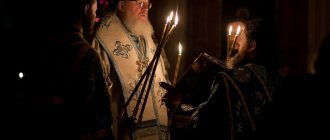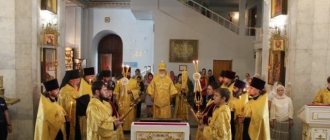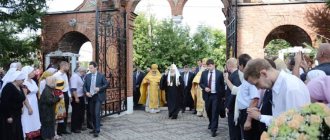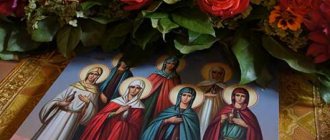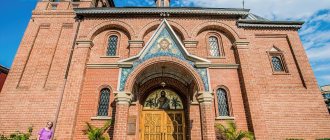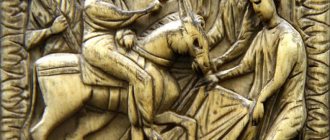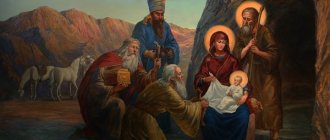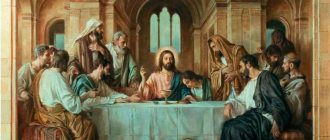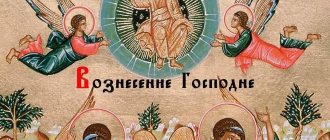The prayer “Now let Thy servant go,” also known as the Song of Simeon the God-Receiver, has been heard in worship since the first centuries of Christianity.
Text of the prayer in Church Slavonic and Russian
Now do You let Your servant go, O Master, according to Your word, in peace; for my eyes have seen Your salvation, which You have prepared before the face of all people, a light for the revelation of tongues and the glory of Your people Israel
Now do You let Your servant go, O Lord, according to Your word, in peace, because mine eyes have seen Your salvation, which You have prepared in the face of all nations, a light to enlighten the Gentiles and the glory of Your people Israel
Regent Evgeny Svyatoslavovich Tugarinov analyzed for our readers the four most famous musical versions of this chant.
– The text of the prayer “Now you let go” combines Life, which Elder Simeon holds in his arms, and death, his own death, which he is waiting for, which he is not afraid of and which is about to happen “in peace,” that is, in peaceful acceptance the end of his earthly life.
For each composer who set this prayer to music, it was important to express precisely this combination of life and death.
For example, in “Now You Let Go” from Sergei Rachmaninov’s All-Night Vigil, the motif of life is expressed in the choir’s performance of a lullaby. Simeon takes the Child Christ in his arms. What do people do when they take a baby? They rock him. And this “motion sickness” is sung by the choir.
Prayer “Now let us go”, composer Sergei Rachmaninov
And Simeon’s departure is musically depicted at the very end - the bass descends into the very depths of the choral texture - as if to the depths of the grave.
Rachmaninov did not write this work for performance in church; it is unusually complex and accessible only to highly professional choirs; for example, there is a recording of this work in 1966 performed by the Sveshnikov choir.
Evgeny Tugarinov led the London Cathedral Choir from 2001–2014. and Yelokhovsky Epiphany Cathedral in 2014–2017, teacher, author of the book “Russian Regents”, artistic director of the children’s choir studio “Tsarevich” at the Dimitrievskaya School (Moscow)
My spiritual teachers were Metropolitan Anthony of Sourozh and Archpriest Michael Fortunato, regent of the London Assumption Cathedral, people who lived outside of Russia. Abroad, it was customary to sing simple versions of “Now Let You Go” - either in the sixth voice, or by the composer Lvovsky (a four-voice score, very simple and understandable, accessible to any choir).
If we talk about my personal preferences, I like “Now You Let Go” in a more minor, quieter, calmer version than the loud one. And here I would highlight the chants of the 19th century church composer, regent of Lvovsky, as well as the outstanding regent of the Russian Diaspora Ledkovsky and deacon Sergius Trubachev.
Prayer “Now you let go”, music by Grigory Lvovsky
Grigory Fedorovich Lvovsky (1830–1894) – spiritual composer of the 19th century
For 35 years he was the regent of the Metropolitan Choir of the Alexander Nevsky Lavra and the Choir of St. Isaac's Cathedral. While studying at the Theological Academy, student Ivan Ilyich Sergiev, the future holy righteous John of Kronstadt, often visited Lvovsky, listened to him play the violin and participated in singing under his direction. In his work, Lvovsky paid attention to ancient church chants; he made classic examples of transcriptions of Znamenny and Kyiv chants and wrote a number of original works based on ancient chants. Such attention to ancient melodies was new for that time. His compositions, in comparison with the ornate and lush compositions that then prevailed in the choir, were distinguished by artistic simplicity and rigor. He considered the main thing in church singing to be maintaining a prayerful spirit, and church singers should pay attention not only to one sound aspect, but mainly to the meaning and spirit of the chant, and be in inextricable connection with the clergy while singing. In a memorandum submitted by him to the Synod, he wrote that “vocal and other ancient church melodies should, when harmoniously combined, remain inviolable, like the text of Holy Scripture.”
But people have different tastes, different spiritual experiences. Someone will say that there is nothing better than the sixth tone, and someone will say that there is nothing better than Rachmaninoff.
Prayer “Now you let go”, music by Boris Ledkovsky
Boris Mikhailovich Ledkovsky (1894–1975) – regent and composer of the Russian Diaspora
Born into a priest's family, from the age of 14 he directed the church choir in his father's parish. Studied at the Moscow Conservatory. He served in the units of General Wrangel, and in 1921 he went to Bulgaria with the Russian army. He directed church choirs in Bulgaria, France, and Germany. Since 1952, regent of the Synodal Znamensky Cathedral in New York and teacher at St. Vladimir's Seminary. Under the leadership of Ledkovsky, the choir of the Synod of the Russian Orthodox Church Abroad became one of the best singing groups in the Russian Diaspora. As the author of church music, Ledkovsky considered it important to fully or partially preserve authentic church chants and was concerned about the revival of ancient chants in worship. His works corresponded to the performing capabilities of small foreign choirs, so that small choirs or even quartets could sing quite complex chants, avoiding operatic effects.
Brief Life
Memorial Day February 3/16
He lived for about 270 years waiting for what God promised - the day when he would see the Messiah together with His Most Pure Mother. He was at the Jerusalem Temple and, having met the long-awaited Infant of God, took Him in his arms and said: “Now, Lord, you are letting Your servant go in peace, according to Your word...” Righteous Simeon is a helper in old age, a prayer book for a peaceful departure from life and Christian parting words.
Menea. February 3rd.
- Voice in the Dictionary.
- Akathist to the righteous Simeon the God-Receiver.
- Canon to the holy righteous Simeon the God-Receiver.
What does it mean to pray during a service?
Sometimes you can hear: “You can pray to this chant, but not to that.” In my opinion, this is all subjective. One person prays in silence, while another may pray in a noisy square. Praying during a service, it seems to me, does not mean going into your personal experiences, it means responding with your consciousness and heart to the words that are currently being sung or read.
Then it will be a real temple prayer. And only it is capable of creating the unity of the people as the Body of God, the Body of Christ, which is the community of people who come and take communion at the liturgy.
What is prayerful and non-prayerful singing? If we do not understand the words, if we cannot follow the words, but only the musical development, this is not prayerful singing. And if, even in a complex chant, we clearly hear the words and discover their meaning, such singing can be called prayerful.
We are preparing for the service of the Presentation of the Lord: “Now you let go...”
The first mention of the celebration of the Presentation of the Lord is found in the practice of the Jerusalem Church in the 4th century, according to the testimony of the Roman pilgrim Eteria. This day did not yet have a name familiar to us and was not completely independent, being, as it were, a celebration of the general holiday of Epiphany. It took place on the 40th day after this holiday. On this day, special processions with lamps were provided, as if in fulfillment of the Gospel words that Christ came as “Light in the revelation of tongues.”
In the 6th century, in the practice of Constantinople, the Presentation became an independent holiday and actively spread. It has a name that marks the meeting of the infant Christ with Simeon and Anna as representatives of the Old Testament people of God, looking forward to the deliverance of Israel. But there was another name for the holiday - “Cleansing of Mary,” emphasizing the idea of the Old Testament cleansing of the Mother after childbirth. According to the typikon, the Presentation was established as a feast of the Theotokos, but with elements of the Lord.
During the time of Emperor Justinian, at least two strong earthquakes occurred in Byzantium (VI century), and a severe pestilence hit Constantinople. In these terrible days of nationwide disasters, it was revealed to one of the saints of God that the celebration of the Presentation of the Lord should be celebrated more solemnly. On the day of the Presentation, when they began to perform the all-night vigil and procession together, the disasters ceased due to the goodness of God and the intercession of the Mother of God. The result of this was the order to carry out prayer processions on the day of the holiday, similar to the processions with lamps in the practice of the Jerusalem Church. Towards the end of the 6th century, Pope Gregory Dvoeslov (+604) adopted the tradition of processions on the day of the Presentation and established it in Rome. The statutes of Russian monasteries also preserved remarks about the performance of prayers (litanies) outside the monastery on the day of the Feast of the Presentation between the services of Matins and Liturgy.
Notes of Valaam everyday life
The word “sretenie” translated from Church Slavonic means “meeting”. On the Feast of the Presentation of the Lord, Orthodox Christians remember the day when the Infant Jesus Christ was brought to the Jerusalem Temple in fulfillment of the ancient customs of the Old Testament Law of Moses.
According to the Law of Moses, a woman who gave birth to a male child was considered unclean for 40 days. On the 40th day, she had to offer a burnt offering of a one-year-old lamb in the Jerusalem Temple as a sign of gratitude to the Lord for the gift of the baby. Also a cleansing sacrifice for sin - a young dove or turtle dove. In case of poverty, it was allowed to bring two turtle doves or doves, one for each sacrifice (Leviticus 12:1-8). After these sacrifices, the priest declared the mother in labor clean. All these purification rites related to the mother, not the baby.
Fulfilling the law of Moses, the Blessed Virgin Mary appeared in the temple with the sacrifice allowed to the poor - two doves. Having become the mother of the Lord and without ceasing to be a Virgin, the Most Holy Theotokos did not need purification. But out of deep humility, She obeyed the dictates of the law, so as not to be reproached for violating it. For the mystery of the immaculate conception and birth was not yet known to anyone except the Virgin Mary and Joseph herself. A description of this law is given in the first proverb, read at the all-night vigil of the holiday.
The Most Holy Virgin and Joseph also brought the Child to Jerusalem to do with Him according to legal custom, dedicating Him to the Lord and paying a ransom of five shekels for Him. This law is eloquently evidenced by the irmos of the 9th song of the festive canon:
| Irmos of the 9th song of the holiday canon In the law of the canopy and the scriptures / we see the image, the faithful, / every male sex, opening the false, is holy to God. / Thus, the first-born Word of the Father is without beginning, / the Son of the first-born Matter is unskillfully, / we magnify. | In the shadow and letter of the Law/ we, the faithful, see an image:/ every male creature/ who opens the womb of the mother is dedicated to God;/ therefore the first-born Word,/ the Son of the beginningless Father,/ the first-born of a Mother who knew no husband,/ we magnify. |
In the law of the canopy and the scriptures we see the image, the truth...
The Apostle Paul states: “For the law is a shadow of the good things to come, [and] not the very image of things...”
Translation: “The law is a shadow of the good things to come, and not the very image of things...”
(Heb. 10:1). In this regard, many Old Testament decrees and events are interpreted in the light of the New Testament as prototypes and pre-images of the decrees and events of the Gospel.
...every male sex, opening its lies, is holy to God.
In ancient times, the Israelites were redeemed from slavery by the death of the firstborn of the Egyptians, when on the night before the exodus of the Jews from Egypt, the Angel of the Lord destroyed all the firstborn of the Egyptians. In gratitude for this, the law of the Lord demanded from the Jews (Ex. 13) that every firstborn male child of theirs on the 40th day be brought to the temple of God, dedicated to the Lord and redeemed from the Lord. Thus, the firstborn Jewish children had to be dedicated to serving God at the temple. Over time, when only one tribe of Levi was singled out for this service, the firstborn began to be released from this service for a special ransom of five shekels of silver (Num. 18:16).
The Mother of God, obeying the law, sacrifices the Infant God to God. And this sacrifice becomes an omen of the bloody Sacrifice of Calvary. Old Testament law ( "law and scripture"
) becomes the image of the greatest event in gospel history. He who was to sanctify and redeem all people with priceless blood was Himself first dedicated to God and redeemed with a few coins.
Thus, the firstborn Word of the Father is without beginning, the Son...
The Lord Jesus is the Word, the firstborn Son of God the Father, who has no beginning. By this, the hymnographer points out the divine nature of the Savior, as well as the fact that He was born of the Father, and not created, as the Apostle John says: “In the beginning was the Word, and the Word was with God, and the Word was God.”
(John 1:1).
... we magnify the first-born Matter without artifice.
Here the hymnographer speaks about the human nature of the Lord Jesus, born in the flesh from the Most Holy Theotokos, as the holy evangelist Matthew narrates: “She gave birth to her firstborn Son, and he called His name Jesus.”
(Matt. 1:25). And he calls us all to magnify the Lord Jesus, the firstborn Word of God the Father and firstborn by carnal birth from an unnatural Mother.
In the temple, when the Mother of God offered ransom and sacrifice, the righteous and pious elder Simeon was present, waiting for the “joy of Israel”
, that is, the Messiah promised by God, whose appearance was supposed to bring comfort to Israel (Is. 40:1).
At the inspiration of the Spirit of God, he came to the temple, apparently to where the altar of burnt offering was, and recognized the Messiah-Christ in the Child brought by the Most Holy Virgin. He took Him into his arms, and an inspired prayer poured out of his lips - gratitude to God for allowing him to see in the face of this Baby the salvation prepared for humanity. This wonderful prayer is still heard today in Christian churches during every evening service.
| Prayer of Simeon the God-Receiver Now do You let Your servant go, O Master, / according to Your word in peace; / for my eyes have seen Your salvation, / which You have prepared before the face of all people, / a light for the revelation of tongues, / and the glory of Your people Israel. | Now do You let Your servant go, O Lord,/ according to Your word, in peace,/ for mine eyes have seen Your salvation,/ which You have prepared in the face of all nations:/ a light for revelation to the Gentiles,/ and the glory of Your people Israel. |
Now do You let Your servant go in peace, O Master, according to Your word...
An ancient legend reports that the Egyptian king Ptolemy II Philadelphus (III century BC) wanted to replenish his library with the texts of the Holy Books of the Old Testament. He invited scribes from Jerusalem. Among the 72 scholars who arrived in Alexandria to translate the Holy Scriptures from Hebrew into Greek, righteous Simeon was invited. The righteous man translated the book of the prophet Isaiah. Having read in the original the words “Behold, the Virgin is with child and will give birth to a Son” (Is. 7:14), he decided that the word “Virgin” was used here erroneously, instead of the word “Wife,” and wanted to correct the text. At that moment, an Angel appeared to him and held his hand, saying: “Have faith in the written words, you yourself will be convinced that they will be fulfilled, for you will not taste death until you see Christ the Lord, who will be born of the Pure and Immaculate Virgin.”
From that day on, righteous Simeon began to await the coming of the Promised Messiah. And then this day came, and the righteous man who had been waiting for Him met face to face with God who had become Man. Now he can pass away in peace into eternity.
... for my eyes have seen Your salvation, / which You have prepared before the face of all people...
Righteous Simeon, as a representative of the Old Testament, with great joy saw with his own eyes the Savior promised in the prophecies. The Old Testament meets the New. The righteous man foresees by the Holy Spirit that the Messiah has come to save not only the Jews, but also all nations. And now he can go down to the region of the dead and bring there the first news that he saw God on earth ( “my eyes have seen salvation”
), who came in the flesh.
... a light for the revelation of tongues, / and the glory of Your people Israel.
This salvation is the “Light for the enlightenment of the Gentiles.” This salvation is “the glory of God’s people Israel,” because the first evangelists of salvation and the closest disciples of Christ were the best representatives of the Israelis in the person of the apostles.
There was also the 84-year-old widow Anna in the temple, “who did not leave the temple, serving God day and night with fasting and prayer. And at that time she came up and glorified the Lord and spoke about Him to everyone who was waiting for deliverance in Jerusalem” (Luke 2:36-38), which is why she is called a prophetess. So clearly and majestically the Divinity was revealed in the forty-day-old Infant. By those awaiting the “joy” of Israel, He was recognized and glorified as Christ, the Savior of the world and Lord.
According to Anthony, Metropolitan of Sourozh, “each of us once, on the day of our churching, was brought to the temple; each of us was placed before God to become His property; <…> we were all brought and given to God, just as the Infant Christ was brought by His Mother. <…> Let us think, each of us, about what it means that he or she was once brought to the temple, given to God with maternal love; given to the keeping of Him who is the Guardian of infants, given to Him who is the Lord and the Life. Let's think about whether we are able to meet Christ as Simeon and Anna met Him. Amen"
.
In the next article there is a commentary on the troparion and kontakion of the holiday
***
The following materials were used in preparing the article:
- Translation of liturgical texts by Fr. Ambrose (Timrot).
- Prot. Grigory Debolsky. Days of Divine Services of the Orthodox Catholic Eastern Church.
- Archbishop Averky (Taushev). A Guide to Studying the Holy Scriptures of the New Testament. Four Gospels.
- Malkov P.Yu. The Presentation of the Lord - history, spiritual meaning and liturgical features of the holiday.
- Bishop Vissarion (Nechaev). Interpretation on proverbs.
- Chants of the brethren of the Valaam Monastery.
- Music collection of Valaam everyday life.
***
The Irmos of the 9th canto is sung not only at Matins during the reading of the canon, but also at the Liturgy as a chant instead of “It is worthy to eat...” (Zadostoynik) in the period before the celebration of the holiday. The irmos given at the beginning of the article is sung precisely at the Liturgy with a znamenny chant.
And the irmos below is sung in the Valaam chant at the festive canon:
Kiev chant of the prayer “Now you let go” as presented by Deacon Sergius Trubachev
Deacon Sergiy Trubachev (1919–1995) – conductor, teacher, church composer, regent
Born into the family of Archpriest Zosima Trubachev, a future martyr who was shot in Butovo in 1938. He graduated from the Gnessin Music School and the Moscow Conservatory. He was a conductor of a symphony orchestra in Karelia, taught at the Gnessin Institute, and trained many orchestral conductors over the years of teaching. Since 1980, he completed his secular activities and completely devoted his life to church creativity. In 1995 he was ordained deacon. Without works by Fr. It is impossible to imagine modern Orthodox worship of Sergius Trubachev. His compositions and prayerful harmonizations, canonically traditional, are performed in all churches in Russia.
